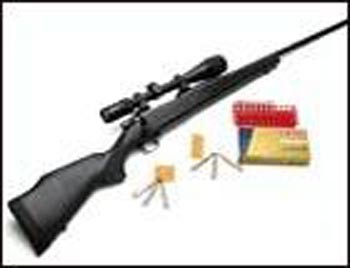Weatherby Vanguard .257 Magnum rifle review

Weatherby Vanguard .257 Magnum rifle review
Manufacturer: Weatherby
Weatherby Vanguard .257 Magnum rifle review.
Mention the name Weatherby and romantic notions of African safaris with large-calibre American magnum rifles come to mind. Indeed, Roy Weatherby made his name through rifles of quintessentially American flavour, big and powerful.
Proprietary calibres ranging from the .224 Weatherby magnum, through the .257, .270 and .300 calibres, to the large .378 and .460 Weatherbys have earned his rifles a hard-hitting reputation for high velocity. All this came at a price, however, and because many US shooters wanted the name without the price tag, Roy Weatherby came up with an alternative rifle of similar design that utilised more common calibres, as well as his own cartridge range.
The Vanguard has characteristics similar to those of the top-flight Mark V, but is a cheaper clone. To make it affordable, a few compromises had to be made, including out-sourcing production to Japan. I tested a Browning A-Bolt recently with the same oriental origins and was impressed with both quality and performance.
Stylish action
Unlike the Mark V action, the Vanguard utilises a more conventional long- and bolt-action design, centring around a locking two-lug 90degree lift bolt operation in a one-piece forged action body. The design is stylish yet strong and the bolt is fluted for visual appeal rather than any real weight-saving ability. This also aids in smooth bolt operation. Should you encounter a pierced primer, three venting holes on the bolt body channel hot gases away. Fired cases are dealt with by a large, positive and energetic claw extractor. The opposing twin locking lugs are suitably large and offer good structural integrity. To maximise safety, the cartridge case head is encased in ‘three rings of steel’, which include the recessed bolt face, barrel and receiver ring. A reliable action, it also comes drilled and tapped to accept a variety of scope bases and mounts.
Simple safety
A simple safety lever sits on the right side of the receiver body: forward to ‘F’ for fire, and a short, silent repositioning to the rear puts the rifle on ‘S’ for safe, effectively locking the trigger sear and action. A convenient cocking indicator at the rear of the cocking shroud shows a protrusion if the rifle is cocked.
Trigger setting
The rifle is fitted with a fully adjustable trigger, which is hard at factory setting and has a lot of creep to it. The let-off was predictable, however, and a qualified gunsmith should be able to refine the trigger pull to suit.
Solid stock
The Vanguard sports the popular synthetic stock design: a black injection-moulded composite aimed at the stalking market. It is solidly constructed, which helps not only in reducing felt recoil, but also in providing a reasonably stable platform. Moulded-in chequered panels on the fore-end and pistol grip are adequate for grip but not very attractive. A classic sporter look, it has a low comb, cheek piece with rubber recoil pad and a set of quick detachable swivel studs.
Barrel for accuracy
Of slim profile (between 2 and 3 contour) and 24in long, the barrel is cold hammer-forged and guaranteed to shoot a 1.5in group at 100 yards or better from a three-shot group. True 1.5in at 100 yards is fair accuracy, but at least you have a good starting point if you wish to reload for your rifle and shrink those groups somewhat. The barrel is not free-floating, instead it forms the solid integrity of the stock design, meaning the fit is complete – not ideal by any means, but if accuracy is guaranteed, who’s to argue?
Clever magazine
The magazine is fed via a hinged floorplate and the .257 Weatherby on test allows three shots to be loaded, with a further one in the breech. The floorplate is a one-piece metal construction, while the hinged section is a combination of steel and lightweight alloy. Not as convenient as a detachable magazine, the design does allow a fast reliable means of unloading.
On the range
The test rifle was chambered in .257 Weatherby magnum, a fast-stepping cartridge capable of sending a 100-grain bullet downrange at 3,600fps velocity, producing 2,880ft/lb energy. I used to own a .257 Accumark Mark V Weatherby and luckily still had reloading dyes, cases and some Federal factory ammunition.
After sighting-in the Vanguard at 100 yards, the Federal ammunition shot an average of five three-shot groups of 1.55in, backing up Weatherby’s claim to 1.5in MOA accuracy. I fitted a PES T12 sound moderator during the tests to reduce felt recoil, with the result that recoil was no more than a 6.5-55 cartridge; without it there was noticeably more rearward movement and muzzle jump.
A load of 71.0 grains of RL22 Powder ignited by a Federal Magnum primer under a Nosler 100-grain ballistic tip bullet produced a healthy 3,451fps and 2,645ft/lb energy and grouped in less than 1in at 100 yards. Though not maximum load, velocity was good enough and, more importantly, the accuracy peaked with this load. I also worked up a superb super-flat fox round utilising the light 75-grain V-Max bullet from Hornady, sending it speeding across the chronograph at nearly 4,000fps with 2,665ft/lb energy. Accelerated throat erosion in the barrel will stop such antics, but it shows the potential of round and rifle.
I liked the Vanguard: it had no pretentions beyond being a good-value synthetically-stocked no-nonsense stalking rifle with a guaranteed accuracy level. At £545 it represents good value, too, but if you want a slightly better stock and better accuracy, you can upgrade to the sub-MOA model.
Weatherby Vanguard
Price: £545
PROS
– Guaranteed accuracy
– Solid construction
– Cheap magnum class rifle
CONS
– Non-floated barrel
– Heavy trigger pull
MORE INFORMATION
For more information, contact Garlands, Tel 01827 383300, the UK’s official Weatherby importers.








